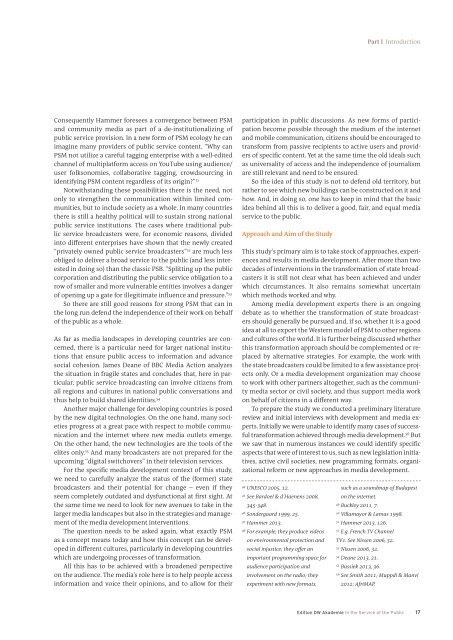edition-dw-akademie-in-the-service-of-the-public-functions-and-transformation-of-media-in-developing-countries-pdf
edition-dw-akademie-in-the-service-of-the-public-functions-and-transformation-of-media-in-developing-countries-pdf
edition-dw-akademie-in-the-service-of-the-public-functions-and-transformation-of-media-in-developing-countries-pdf
Create successful ePaper yourself
Turn your PDF publications into a flip-book with our unique Google optimized e-Paper software.
Part I IntroductionConsequently Hammer foresees a convergence between PSM<strong>and</strong> community <strong>media</strong> as part <strong>of</strong> a de-<strong>in</strong>stitutionaliz<strong>in</strong>g <strong>of</strong><strong>public</strong> <strong>service</strong> provision. In a new form <strong>of</strong> PSM ecology he canimag<strong>in</strong>e many providers <strong>of</strong> <strong>public</strong> <strong>service</strong> content. “Why canPSM not utilize a careful tagg<strong>in</strong>g enterprise with a well-editedchannel <strong>of</strong> multiplatform access on YouTube us<strong>in</strong>g audience/user folksonomies, collaborative tagg<strong>in</strong>g, crowdsourc<strong>in</strong>g <strong>in</strong>identify<strong>in</strong>g PSM content regardless <strong>of</strong> its orig<strong>in</strong>?” 51Notwithst<strong>and</strong><strong>in</strong>g <strong>the</strong>se possibilities <strong>the</strong>re is <strong>the</strong> need, notonly to streng<strong>the</strong>n <strong>the</strong> communication with<strong>in</strong> limited communities,but to <strong>in</strong>clude society as a whole. In many <strong>countries</strong><strong>the</strong>re is still a healthy political will to susta<strong>in</strong> strong national<strong>public</strong> <strong>service</strong> <strong>in</strong>stitutions. The cases where traditional <strong>public</strong><strong>service</strong> broadcasters were, for economic reasons, divided<strong>in</strong>to different enterprises have shown that <strong>the</strong> newly created“privately owned <strong>public</strong> <strong>service</strong> broadcasters” 52 are much lessobliged to deliver a broad <strong>service</strong> to <strong>the</strong> <strong>public</strong> (<strong>and</strong> less <strong>in</strong>terested<strong>in</strong> do<strong>in</strong>g so) than <strong>the</strong> classic PSB. “Splitt<strong>in</strong>g up <strong>the</strong> <strong>public</strong>corporation <strong>and</strong> distribut<strong>in</strong>g <strong>the</strong> <strong>public</strong> <strong>service</strong> obligation to arow <strong>of</strong> smaller <strong>and</strong> more vulnerable entities <strong>in</strong>volves a danger<strong>of</strong> open<strong>in</strong>g up a gate for illegitimate <strong>in</strong>fluence <strong>and</strong> pressure.” 53So <strong>the</strong>re are still good reasons for strong PSM that can <strong>in</strong><strong>the</strong> long run defend <strong>the</strong> <strong>in</strong>dependence <strong>of</strong> <strong>the</strong>ir work on behalf<strong>of</strong> <strong>the</strong> <strong>public</strong> as a whole.As far as <strong>media</strong> l<strong>and</strong>scapes <strong>in</strong> develop<strong>in</strong>g <strong>countries</strong> are concerned,<strong>the</strong>re is a particular need for larger national <strong>in</strong>stitutionsthat ensure <strong>public</strong> access to <strong>in</strong>formation <strong>and</strong> advancesocial cohesion. James Deane <strong>of</strong> BBC Media Action analyzes<strong>the</strong> situation <strong>in</strong> fragile states <strong>and</strong> concludes that, here <strong>in</strong> particular,<strong>public</strong> <strong>service</strong> broadcast<strong>in</strong>g can <strong>in</strong>volve citizens fromall regions <strong>and</strong> cultures <strong>in</strong> national <strong>public</strong> conversations <strong>and</strong>thus help to build shared identities. 54Ano<strong>the</strong>r major challenge for develop<strong>in</strong>g <strong>countries</strong> is posedby <strong>the</strong> new digital technologies. On <strong>the</strong> one h<strong>and</strong>, many societiesprogress at a great pace with respect to mobile communication<strong>and</strong> <strong>the</strong> <strong>in</strong>ternet where new <strong>media</strong> outlets emerge.On <strong>the</strong> o<strong>the</strong>r h<strong>and</strong>, <strong>the</strong> new technologies are <strong>the</strong> tools <strong>of</strong> <strong>the</strong>elites only. 55 And many broadcasters are not prepared for <strong>the</strong>upcom<strong>in</strong>g “digital switchovers” <strong>in</strong> <strong>the</strong>ir television <strong>service</strong>s.For <strong>the</strong> specific <strong>media</strong> development context <strong>of</strong> this study,we need to carefully analyze <strong>the</strong> status <strong>of</strong> <strong>the</strong> (former) statebroadcasters <strong>and</strong> <strong>the</strong>ir potential for change – even if <strong>the</strong>yseem completely outdated <strong>and</strong> dysfunctional at first sight. At<strong>the</strong> same time we need to look for new avenues to take <strong>in</strong> <strong>the</strong>larger <strong>media</strong> l<strong>and</strong>scapes but also <strong>in</strong> <strong>the</strong> strategies <strong>and</strong> management<strong>of</strong> <strong>the</strong> <strong>media</strong> development <strong>in</strong>terventions.The question needs to be asked aga<strong>in</strong>, what exactly PSMas a concept means today <strong>and</strong> how this concept can be developed<strong>in</strong> different cultures, particularly <strong>in</strong> develop<strong>in</strong>g <strong>countries</strong>which are undergo<strong>in</strong>g processes <strong>of</strong> <strong>transformation</strong>.All this has to be achieved with a broadened perspectiveon <strong>the</strong> audience. The <strong>media</strong>’s role here is to help people access<strong>in</strong>formation <strong>and</strong> voice <strong>the</strong>ir op<strong>in</strong>ions, <strong>and</strong> to allow for <strong>the</strong>irparticipation <strong>in</strong> <strong>public</strong> discussions. As new forms <strong>of</strong> participationbecome possible through <strong>the</strong> medium <strong>of</strong> <strong>the</strong> <strong>in</strong>ternet<strong>and</strong> mobile communication, citizens should be encouraged totransform from passive recipients to active users <strong>and</strong> providers<strong>of</strong> specific content. Yet at <strong>the</strong> same time <strong>the</strong> old ideals suchas universality <strong>of</strong> access <strong>and</strong> <strong>the</strong> <strong>in</strong>dependence <strong>of</strong> journalismare still relevant <strong>and</strong> need to be ensured.So <strong>the</strong> idea <strong>of</strong> this study is not to defend old territory, butra<strong>the</strong>r to see which new build<strong>in</strong>gs can be constructed on it <strong>and</strong>how. And, <strong>in</strong> do<strong>in</strong>g so, one has to keep <strong>in</strong> m<strong>in</strong>d that <strong>the</strong> basicidea beh<strong>in</strong>d all this is to deliver a good, fair, <strong>and</strong> equal <strong>media</strong><strong>service</strong> to <strong>the</strong> <strong>public</strong>.Approach <strong>and</strong> Aim <strong>of</strong> <strong>the</strong> StudyThis study’s primary aim is to take stock <strong>of</strong> approaches, experiences<strong>and</strong> results <strong>in</strong> <strong>media</strong> development. After more than twodecades <strong>of</strong> <strong>in</strong>terventions <strong>in</strong> <strong>the</strong> <strong>transformation</strong> <strong>of</strong> state broadcastersit is still not clear what has been achieved <strong>and</strong> underwhich circumstances. It also rema<strong>in</strong>s somewhat uncerta<strong>in</strong>which methods worked <strong>and</strong> why.Among <strong>media</strong> development experts <strong>the</strong>re is an ongo<strong>in</strong>gdebate as to whe<strong>the</strong>r <strong>the</strong> <strong>transformation</strong> <strong>of</strong> state broadcastersshould generally be pursued <strong>and</strong>, if so, whe<strong>the</strong>r it is a goodidea at all to export <strong>the</strong> Western model <strong>of</strong> PSM to o<strong>the</strong>r regions<strong>and</strong> cultures <strong>of</strong> <strong>the</strong> world. It is fur<strong>the</strong>r be<strong>in</strong>g discussed whe<strong>the</strong>rthis <strong>transformation</strong> approach should be complemented or replacedby alternative strategies. For example, <strong>the</strong> work with<strong>the</strong> state broadcasters could be limited to a few assistance projectsonly. Or a <strong>media</strong> development organization may chooseto work with o<strong>the</strong>r partners altoge<strong>the</strong>r, such as <strong>the</strong> community<strong>media</strong> sector or civil society, <strong>and</strong> thus support <strong>media</strong> workon behalf <strong>of</strong> citizens <strong>in</strong> a different way.To prepare <strong>the</strong> study we conducted a prelim<strong>in</strong>ary literaturereview <strong>and</strong> <strong>in</strong>itial <strong>in</strong>terviews with development <strong>and</strong> <strong>media</strong> experts.Initially we were unable to identify many cases <strong>of</strong> successful<strong>transformation</strong> achieved through <strong>media</strong> development. 56 Butwe saw that <strong>in</strong> numerous <strong>in</strong>stances we could identify specificaspects that were <strong>of</strong> <strong>in</strong>terest to us, such as new legislation <strong>in</strong>itiatives,active civil societies, new programm<strong>in</strong>g formats, organizationalreform or new approaches <strong>in</strong> <strong>media</strong> development.44UNESCO 2005, 12.45See Bardoel & d’Haenens 2008,345-348.46Sondergaard 1999, 25.47Hammer 2013.48For example, <strong>the</strong>y produce videoson environmental protection <strong>and</strong>social <strong>in</strong>justice; <strong>the</strong>y <strong>of</strong>fer animportant programm<strong>in</strong>g space foraudience participation <strong>and</strong><strong>in</strong>volvement on <strong>the</strong> radio; <strong>the</strong>yexperiment with new formats,such as a soundmap <strong>of</strong> Budapeston <strong>the</strong> <strong>in</strong>ternet.49Buckley 2011, 7.50Villamayor & Lamas 1998.51Hammer 2013, 126.52E.g. French TV ChannelTV1. See Nissen 2006, 32.53Nissen 2006, 32.54Deane 2013, 21.55Bussiek 2013, 36.56See Smith 2011; Muppdi & Manvi2012; AfriMAP.Edition DW Akademie In <strong>the</strong> Service <strong>of</strong> <strong>the</strong> Public 17


